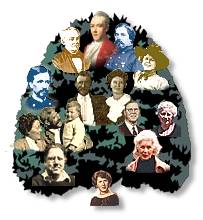Sidney Breese was on the point of mounting his horse to join the rebellion of the Jacobites in 1720 when
the news of some reverse to the adherents of the Pretender saved him from committing so rash an act.
He later entered the English Navy and served as Purser of H.M.S. Centaur for several years.
After surrendering his commission, Sidney opened a store for rich goods like laces and
brocades. "As honest as Sidney Breese, whose 'word is as good as his bond,'" became proverbial.
After a run of bad luck in business, Sidney's creditors insisted upon his continuing in his business. He
yielded to their wishes and after the lapse of a few years gave a dinner-party, inviting all those
to whom he was indebted; and, as each guest turned his plate up, he found beneath a check for the
full amount due him, with accrued interest to date. This agreeable surprise resulted in a most
convivial, jolly dinner, and was often spoken of, in terms of the greatest enthusiasm, by those
who survived him.
In 1763 he was "Master of the Port of New York."
He was also noted for his genial disposition and hospitality, as well as for his musical taste and voice:
he sang a good song, and his society was much courted, especially by British officers, among whom he
was naturally thrown.
He was fond of a good glass of wine, and sent to England for his bottles, called Magnums, with 'Sidney Breese, 1765,'
stamped in the glass. He later felt the undesirableness of such a gay life as he led, and would not
permit his son to be even taught to sing.
Besides his home in the city, Sidney had a country-house at Shrewsbury in New Jersey, which was enlarged and
altered by his son. In 1862 the house retained the marks of old-fashioned respectability in its large hall,
wainscotings, Dutch tiles around the fire-place in the dining room, etc.
A portrait of Sidney Breese by an unknown artist existed in 1885.
He died of "gout in his head and stomach," at the age of 58 years, and was buried in Trinity churchyard.
In Harper's New Monthly Magazine for November, 1876, pp. 868-9, will be found a woodcut of his headstone
with its inscription and a brief notice written by Mrs Martha J. Lamb. "one of the wittiest, most eccentric,
as well as one of the handsomest men of his time."
Sidney's wife, Elizabeth, was, according to tradition, a natural daughter of Lord Camden, born in England. She
is believed to have made a runaway match. A portrait of her existing in Oneida NY in 1885 showed a stately lady,
richly dressed, with sprightly countenance and determined mien. She was a handsome woman with great energy and
self-reliance, a very decided Whig, a warm supporter of this country and its institutions."
3







 Copyright © 1997, Mary S. Van Deusen
Copyright © 1997, Mary S. Van Deusen